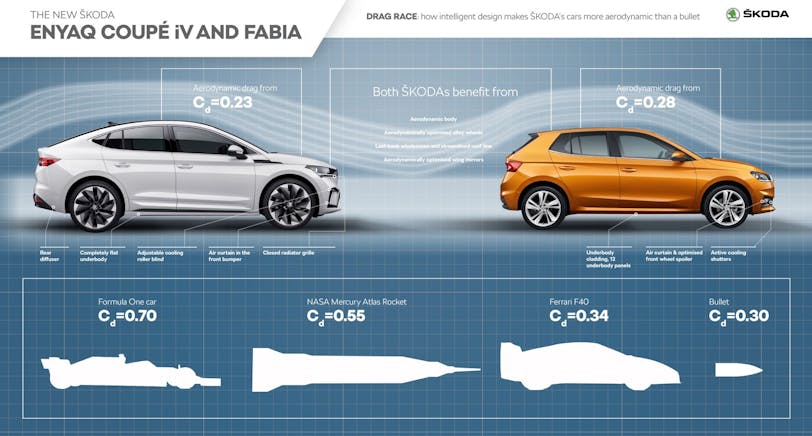ŠKODA Beats A Bullet In A Drag Race
Skoda’s ENYAQ Coupe iV and Fabia are now able to claim a very unique accolade – both are able to beat a bullet in a drag race.
This isn’t your standard 1/4 mile drag race though. Or indeed a Ru Paul outing. We’re referring to the constant race to improve the drag co-efficient of new vehicles. With drag coefficients of 0.23 and 0.28 respectively, the ENYAQ Coupe and Fabia cut through air seamlessly when compared to a bullet – which has a paltry drag co-efficiency of 0.30 in comparison.
What does drag co-efficient mean?
An object’s drag co-efficient, often written as ‘Cd’, refers to how aerodynamic that object is. The lower the number, the more easily it passes through the air. The better the drag co-efficient, the less power wasted propelling that object.
(We know lots of the jargon used within the world of electric vehicles can be confusing, which is why we created a Glossary of Terms which explains every acronym and term you’ll come across.)

How did Skoda achieve such a low drag co-efficient?
In regards to the Enyaq Coupe iV, the car is clearly designed to enhance its aerodynamic capabilities. The bodywork is streamline, with a clever active roller blind shutter at the nose of the car – this adjusts the size of the front cooling grille when necessary. The front apron houses specially designed spoilers that sit in front of the wheels, funnelling air around the car. Wheels are an important consideration. Accounting for 25% of the total air resistance, Skoda optimised their alloys with an aerodynamic design, counteracting at least some of the drag produced.
To accommodate the car leaving the airflow – or ‘wake turbulence’ – Skoda spent lots of time in the wind tunnel to create an ‘aerodynamically optimised roof profile.’ This design choice is complimented by the low-drag wing mirrors, a completely flat underbody and a coordinating rear diffuser.
The culmination of Skoda’s engineers’ hard work is clear. They can unequivocally claim that they have two cars that are significantly more aerodynamic than a speeding bullet. In ‘real’ terms though, these cars are leaders in their respective classes. Breakthroughs in aerodynamically-focussed design will help improve EV range, efficiency and subsequently reduce energy usage.
What does the Skoda ENYAQ Coupe iV have a better drag co-efficient than?
As seen in Skoda’s infographic above, the Czech auto-manufacturer has compared their models with three other unexpected vehicles.
With a drag co-efficient of 0.70, the Formula 1 car may appear to be extremely inefficient. In reality, Formula 1 cars are less about avoiding drag, as they are utilising the physics behind aerodynamics and drag in their favour to increase lap times. It’s technical wizardry beyond our comprehension, but their 0.70 Cd is not by accident.
Arguably the best supercar ever made, Ferrari F40 posters have adorned bedroom walls ever since its release. This prancing horse has a drag co-efficient of 0.34, 0.09 higher than the Skoda. Three decades of automotive engineering has allowed an all-electric SUV pass through air more efficiently than a $400,000 supercar. Although if you wanted one today, an F40 would cost you nearer the £1million mark. Ouch. Either way, it’s a stark difference and a great example of how the automotive industry has come.